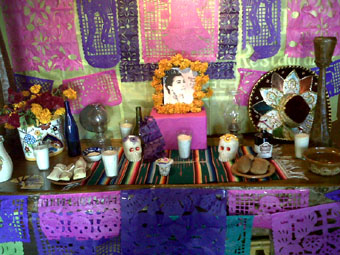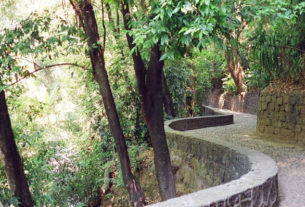Unique observances that exemplify the fusion of Mesoamerican and European cultures, particularly regarding religious practices, render Mexico’s celebration of los Dias de los Muertos as the most distinctive holiday on the nation’s calendar. Customs associated with this festive time of remembrance defy any strict formula, for the practices specific to each region vary considerably. Among the common threads that run nationwide are family visits to local cemeteries to decorate the tombs of deceased relatives, and the installation of memorial altars where special offerings are laid out with the intention of calling home the spirits of the dead.

In the pre-Hispanic era the Aztecs honored their dead with celebrations tied in with the harvest season. The ancient calendar called for festivities in remembrance of deceased children, called Miccailhuitontli (Little Feast for the Dead), around mid-August, immediately followed by Hueymiccaihuitl (Great Feast for the Dead) and Xocotl Huetzi (Falling of Fruit). Conserving some aspects of these annual rituals, but linking them instead to the observance of All Saints Day, November 1, and All Souls Day, November 2, was a factor that helped early Spanish missionaries successfully bring about the conversion of Mexico’s indigenous people to the Christian religion. It is precisely this synthesis of old and new worlds customs that makes Dia de Muertos so intriguing.
According to century’s old beliefs, the souls of the dead return to earth for one day of the year, wending their way home once the sun passes its zenith on November first. This is the time for families to begin setting up the traditional altar de muertos, laying out an offering of items intended to draw the dead and ease their journey homeward.
The altar in usually set up on a tabletop where different sized boxes or shelves are stacked up and draped with hand-embroidered napkins and tablecloths. A backdrop in created with swags of fine cloth or purple crepe paper, along with bright tissue paper cut-outs–called papel picado . Key elements of the ofrenda, laid out in a colorful and eye-pleasing symmetrical composition, are steeped in symbolism with roots in both Christian and indigenous beliefs.
The use of papel picado is derived from the Aztec practice of using paper banners in connection with important religious rituals. In its finest form today, the skillful hands of craftsmen wielding sharp blades are seen in the whimsical skeletons, flowers, birds and intricate windowpane designs carved out of delicate papel de china (tissue paper). Housewives and school children produce simpler versions of the cut-outs by folding the paper and snipping out geometric patterns with scissors. Common colors selected for the altar de muertos –purple to symbolize mourning and hot pink or bright orange to signify the joyful return of the departed–underline the bittersweet nature of the holiday.
A small ceramic brazier placed on the altar is used for burning copal, a pine resin incense the Aztecs used long ago in offerings to their gods. The pungent odor is believed to attract the souls of the dead, as well as to ward off evil spirits. Another lure is the distinctive fragance of the marigold, the traditional Day of the Dead flower still known by its Nahuatl moniker, cempazuchitl *. Petals of the golden blossom are often laid out on the ground to form a path leading to the altar. Marigolds may also be strung in garlands, fixed onto a wreath or cross-shaped base, or arranged in clay pots to adorn the offering. Stalks of deep red cockscombs and other seasonal blossoms may be mixed in for added color.
(* Sometimes written zempasuchitl, cempoalxochitl , or in other forms. Nahautl words are subject great variation in spellings. As the language was originally expressed graphically through hieroglyphs, early Spanish missionaries based themselves on phonetics to commit words to writing in their own language.)
Elements of the ofrenda coming from Christian tradition include candles and votive lights–representing faith and hope– used to light the way for departed souls. In some homes one candle is illuminated for each deceased member of the family. Four candles may be placed in a cross formation, pointing out the four cardinal points to serve as kind of compass. Similarly, a cross may be formed at the foot of the altar using marigold petals, earth or ashes. Images of favorite saints are frequently placed on the altar to elicite special divine protection for loved ones in the afterlife.
Family photographs are set out on the altar to recall the individuals being honored. A washbasin, towel, soap and mirror are placed nearby so that returning spirits can freshen-up before beginning to feast on their once favorite foods.
A typical regional repast is set out in assorted clay pots. The menu may range from a simple fare of tamales to a complete meal of meat or poultry in mole, pepian, or adobo sauce, accompanied by a platter of rice. A dish of salt is included both as a seasoning and an element of purification. These foods are invariably accompanied by the traditional pan de muerto –sugar-coated breads shaped either into round loaves adorned with bits of dough shaped like bones and tears, or human forms, called ánimas (souls).
Chunks of calabaza en tacha (pumpkin cooked in a brown sugar syrup) are indispensable to satiate the sweet tooth, as are skulls, coffins and other deathly figures made of sugar, chocolate or honey-sweetened amaranth seed. Sugar skulls are often inscribed across the forehead with the departed loved one’s name. Other goodies may include slices of alfajor – coconut candy, bits of sugar cane and assorted fresh fruits of the season that may be studded with small papel picado banners.
A jug of fresh drinking water, a glass of fruit-flavored agua fresca, and a cup of atole or chocolate will be offered as thirst-quenchers, while pulque, beer or tequila are served up as reminders of the good times spent on earth.
The altar may be personalized with appurtenances that were essential in the deceased’s daily life. A petate (straw mat) denotes both the traditional bed and precursor to the wooden coffin. For a woman there may be a metate and a molcajete for grinding corn masa and other cooking ingredients, a rebozo (shawl), and a basket filled with needlework materials. A gourd for carrying water, a machete, hat, serape, morral (shoulder bag), and pair of huaraches are typically displayed for a man.
A guitar, violin or other instrument might be provided for a defunct musician. The former smoker will be treated to a pack of his or her favorite brand, accompanied by the requisite box of matches. Small skeleton figures exlusive to the person’s trade or profession may also be added.
For the angelitos (little angels) who have died in infancy, and presumably free of sin, the ofrenda is laid out one day early, in conjunction with All Saints Day. The offering for little ones customarily features traditional wooden or tin toys, along with sweets and a cup of atole or milk. Floral arangements often feature nube (baby’s breath).
As a whole the altar de muerto makes for a scenic setting where departed spirits will feel at home to feast and hold a reunion with living relatives. The ofrenda is one manifestation of the philosophical acceptance of death as an integral part of the life cycle that distinguishes Mexican culture. This phenomenen is explained in greater depth in the well-known essay collection “The Labyrinth of Solitude,“ by the late Nobel prize winning writer Octavio Paz.
(This article originally appeared in the October 30, 1999 issue of the Guadalajara Reporter and is reproduced by Mexico Connect with kind permission of the author.)

